Addiction is a complex condition. It involves a person’s body, mind, behaviors, and more. Addictive substances change the way a person’s body and brain work and make it very hard to stop using them without professional help.
In this article, we will explore highly addictive drugs and how they affect people’s bodies and minds. Contact the Flourishing Foundations Recovery specialists to learn about substance abuse treatment programs. You may also ask questions or schedule an intake assessment.
How Does Addiction Develop?
People may begin using addictive substances for many reasons. People may be curious about their effects or give in to peer pressure.
Some people use drugs or alcohol to cope with emotional pain. They may drink or use drugs to dull feelings of stress, anxiety, sadness, boredom, and more. Mental health professionals call this “self-medication.”
Many addictive substances cause the brain to release more dopamine. Dopamine is a chemical involved in pleasure, reward, and motivation.
People often like the way addictive substances make them feel. They may feel motivated to use more of the drug. After using a substance for some time, they may develop tolerance.
Tolerance means that the brain and body have adjusted to an amount of a substance. People might find that they need to use more drugs or alcohol to get the effects they want.
In time, people may develop physical dependence on drugs or alcohol. This means that their body can’t function without drugs or alcohol. If they try to stop using the substance, they may experience withdrawal symptoms.
It can be very challenging for people with an addiction to stop using drugs or alcohol. People often need treatment and ongoing support to stop using them and avoid relapse.
The Top 10 Most Addictive Drugs
1. Opioids
Opioid drugs are some of the most commonly prescribed medications in the United States. Millions of people use these potent drugs–and many become addicted to them.
Some of the most common prescription opioids include:
- Codeine
- Morphine
- Fentanyl
- Oxycodone
- Hydrocodone
- Meperidine
Opioids bind to receptors in the brain. They affect parts of the brain related to emotional control, pleasure, and pain control.
Opioid addiction can happen quickly, even if they take them exactly as prescribed.
Many people misuse prescription drugs and illicit opioids.
2. Heroin
Heroin is an illicit opioid that is derived from morphine. It is available as a white powder and a black sticky substance called “black tar heroin.”
Users may inject, smoke, or snort heroin.
3. Cocaine
Cocaine is a potent, illicit stimulant drug. People may also call cocaine by other names, including:
- Coke
- Blow
- Rock
- Snow
- Line
- Pearl
- Dust
Cocaine is available as a white powder. Users typically snort, smoke, or inject cocaine.
4. Crack
People make crack by processing cocaine with baking soda and water. This produces a solid form of cocaine called “crack.” People heat crack and inhale the smoke.
The effects of crack don’t last very long. People often use crack frequently, which increases the risk of addiction.
5. Alcohol
Most adults in the United States report drinking alcohol at least occasionally. When people drink, they may experience a range of effects, including:
- Impaired judgment
- Sedation
- Loss of coordination
- Nausea
- Loss of inhibitions
People may use alcohol to self-medicate emotional pain or discomfort. This increases the risk of alcohol addiction.
6. Nicotine
Nicotine is a stimulant drug in tobacco products like cigarettes, chewing tobacco, and cigars. According to the National Institute on Drug Abuse (NIDA), nicotine is the most abused drug in the United States. More than 8.5% of adults in the US had a nicotine addiction in 2020.
7. Prescription stimulants
Some of the prescription medications people take to treat attention deficit hyperactivity disorder (ADHD) can be addictive. Drugs like Adderall, Vyvanse, and Desoxyn are common. However, these drugs are potent and have a high risk of abuse and addiction.
8. Barbiturates and benzodiazepines
People may take prescription barbiturates or benzodiazepines (downers) to reduce symptoms of anxiety and panic disorders. These drugs slow down CNS activity and can help people feel less anxious.
Common “dowers” include:
- Xanax
- Valium
- Klonopin
- Ativan
People may misuse prescription downers or use them recreationally (without a prescription). Excessive central nervous system depression can lead to a life-threatening overdose.
9. Crystal meth
Methamphetamine (meth) is a powerful stimulant. People typically snort, inject, or smoke it. It is a highly addictive illicit drug with dangerous side effects.
10. Methadone
Methadone is an FDA-approved prescription medication. Doctors use it to help patients with opioid use disorder. Methadone works similarly to opioids but doesn’t cause people to feel “high.”
Addiction can occur when a substance increases dopamine in the brain or causes other pleasurable effects. People who become addicted to drugs or alcohol need comprehensive treatment and ongoing support to stop using them and avoid relapse.
Find Substance Use Disorder Treatment
If you or someone you love needs treatment for a substance use disorder, you are not alone. Reach out to the Flourishing Foundations Recovery specialists now to learn about our effective drug detox in San Antonio.
